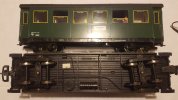Rhinochugger
Retired Oik
The other issue that will make your line more susceptible to unwanted auto-uncoupling is the fact that the stock is four wheeled (not bogie) and fairly long. Any irregularity in the track is likely to be exaggerated at the coupling.I understand what you're saying, assuming "nine in the loco" is a typo for "none on the loco". And yes, you are right that every wagon only has 1 hook.
My observation so far is that these uncouplings only occur when the wagons run with the hook forward. Also, they only occur in certain spots and I suspect a tilt in the track may be part of the issue.
So, further tests are in order. Thanks for your suggestion.
I appreciate your earlier comments on cost, but converting your wagons to bogie stock, and using metal wheels will have your trains running sweetly all day - trust me, I am the forum expert on badly laid track; I have nearly 300 ft of it
However, I also appreciate that the 4w stock that you have may provide the right image for a tramway operation - a dilemma
A cheaper alternative could be to change the couplings to link and pin








